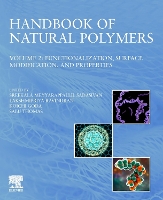


|
|
|
books
| book details |
Handbook of Natural Polymers, Volume 2: Functionalization, Surface Modification, and Properties
Edited by Sreekala Meyyarappallil Sadasivan, Edited by Lakshmipriya Ravindran, Edited by Koichi Goda, Edited by Sabu Thomas

|
| on special |
normal price: R 12 367.95
Price: R 11 749.95
|
| book description |
The Handbook of Natural Polymers, Volume Two: Functionalization, Surface Modification, and Properties covers modifications, functionalization, analysis and properties of polymers from natural sources. The book begins by introducing the current state-of-the-art, challenges and opportunities in natural polymers. This is followed by detailed coverage of methods for chemical, physical and surface modifications, and functionalization of natural polymers, including nanocellulose composites, gluten, chitin, alginate, pectin, keratin, shellac, wool, hemicellulose, lignin, natural rubber, albumin, collagen, gelatin, zein, soya protein, silk fibroin, gutta percha and gum. The final chapters explain several other key aspects, such as microscopical and spectroscopical analysis, mechanical, thermal, and more. The book aims to offer potential avenues for the preparation, modification, and implementation of advanced natural polymer-based materials with the desired properties for specific applications.
| product details |

Normally shipped |
Publisher | Elsevier - Health Sciences Division
Published date | 28 Jun 2024
Language |
Format | Paperback / softback
Pages | 588
Dimensions | 235 x 191 x 0mm (L x W x H)
Weight | 450g
ISBN | 978-0-3239-9856-7
Readership Age |
BISAC | science / chemistry / organic
| other options |
|
|
|
To view the items in your trolley please sign in.
| sign in |
|
|
|
| specials |
|
|

|
Carlo Rovelli
Paperback / softback
208 pages
was: R 295.95
now: R 265.95
|
|

|
Carlo Rovelli
Paperback / softback
224 pages
was: R 295.95
now: R 265.95
|
Originally published in Italian: L'ordine del tempo (Milan: Adelphi Edizioni, 2017).
|
|
|
|